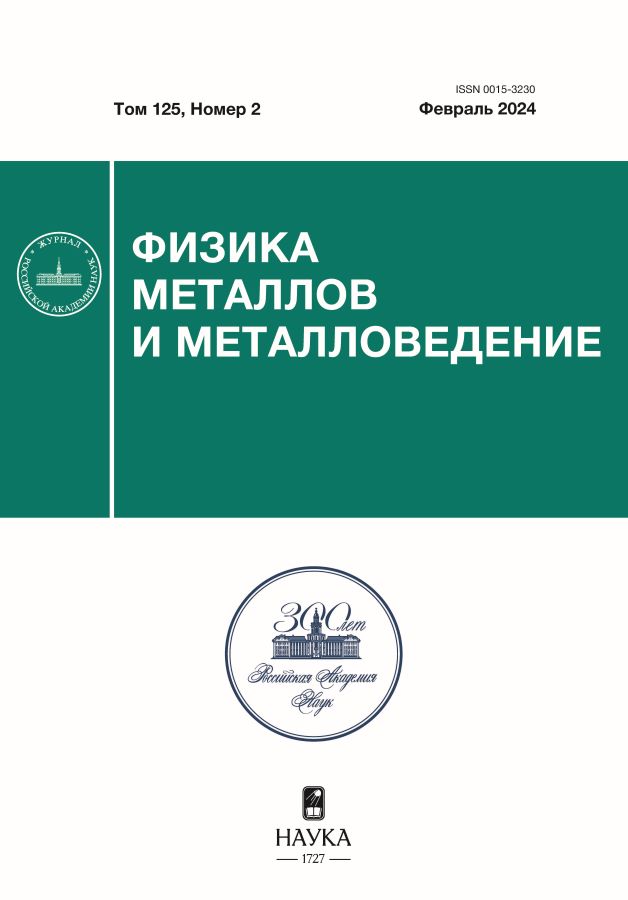Order-disorder phase transitions in Fe81Ga19-RE ALLOYS (RE = Dy, Er, Tb, Yb) according to neutron diffraction data
- Authors: Balagurov A.M.1,2, Yerzhanov B.1, Мухаметулы Б.1,3,4, Samoylova N.Y.1, Palacheva V.V.1,2, Sumnikov S.V.1,2, Golovin I.S.1,2
-
Affiliations:
- Joint Institute for Nuclear Research
- National Research Technological University “MISiS”
- Al-Farabi Kazakh National University
- Institute of Nuclear Physics of the Ministry of Energy of the Republic of Kazakhstan
- Issue: Vol 125, No 2 (2024)
- Pages: 202-213
- Section: СТРУКТУРА, ФАЗОВЫЕ ПРЕВРАЩЕНИЯ И ДИФФУЗИЯ
- URL: https://innoscience.ru/0015-3230/article/view/662832
- DOI: https://doi.org/10.31857/S0015323024020113
- EDN: https://elibrary.ru/YORFPB
- ID: 662832
Cite item
Abstract
New data on the phase compositions and structural transformations in a number of Fe81Ga19 alloys doped with trace amount (≤ 0.2 at.%) of rare earth elements are presented. The data are obtained in neutron diffraction experiments performed with high resolution and in continuous temperature scanning mode when heated to 900 °C and subsequent cooling. It has been established that structural rearrangements proceed in a generally identical manner both in the original Fe81Ga19 alloy and in its doped analogues. Slow heating and subsequent cooling of the alloys (rate ±2 °C/min) leads to the formation of clusters of the D03 phase with sizes in the range (200–300) Å in the matrix of the disordered A2 phase. The sizes and volume fraction of clusters (~0.3 of the sample volume) weakly depend on the specific composition. The degree of ordering of the clusters atomic structure changes with temperature according to a second-order phase transition and is close to unity at room temperature. The search for structural ordering corresponding to the modified D03 phase, discovered in a number of electron diffraction studies, did not lead to a positive result.
Full Text
About the authors
A. M. Balagurov
Joint Institute for Nuclear Research; National Research Technological University “MISiS”
Email: bekarys@jinr.ru
Russian Federation, Dubna, 141980; Moscow, 119049
B. Yerzhanov
Joint Institute for Nuclear Research
Author for correspondence.
Email: bekarys@jinr.ru
Russian Federation, Dubna, 141980
Б. Мухаметулы
Joint Institute for Nuclear Research; Al-Farabi Kazakh National University; Institute of Nuclear Physics of the Ministry of Energy of the Republic of Kazakhstan
Email: bekarys@jinr.ru
Russian Federation, Dubna, 141980; Almaty, 050040 Kazakhstan; Almaty, 050032 Kazakhstan
N. Yu. Samoylova
Joint Institute for Nuclear Research
Email: bekarys@jinr.ru
Russian Federation, Dubna, 141980
V. V. Palacheva
Joint Institute for Nuclear Research; National Research Technological University “MISiS”
Email: bekarys@jinr.ru
Russian Federation, Dubna, 141980; Moscow, 119049
S. V. Sumnikov
Joint Institute for Nuclear Research; National Research Technological University “MISiS”
Email: bekarys@jinr.ru
Russian Federation, Dubna, 141980; Moscow, 119049
I. S. Golovin
Joint Institute for Nuclear Research; National Research Technological University “MISiS”
Email: bekarys@jinr.ru
Russian Federation, Dubna, 141980; Moscow, 119049
References
- Summers E.M., Lograsso T.A., Wun-Fogle M.J. Magnetostriction of binary and ternary Fe–Ga alloys // Mater. Sci. 2007. V. 42. P. 9582–9594.
- He Y., Jiang C., Wu W., Wang B., Duan H., Wang H., Zhang T., Wang J., Liu J., Zhang Z., Stamenov P., Coey J.M.D., Xu H. Giant heterogeneous magnetostriction in Fe–Ga alloys: Effect of trace element doping // Acta Mater. 2016. V. 109. P. 177–186.
- Emdadi A., Palacheva V.V., Balagurov А.M., Bobrikov I.A., Cheverikin V.V., Cifre J., Golovin I.S. Tb-dependent phase transitions in Fe-Ga functional alloys // Intermetallics. 2018. V. 93. P. 55–62.
- Jin T., Wang H., Golovin I.S., Jiang C. Microstructure investigation on magnetostrictive Fe100-xGax and (Fe100-xGax)99.8Tb0.2 alloys for 19 ≤ x ≤ 29 // Intermetallics. 2019. V. 115. P. 106628.
- Wu Y., Chen Y., Meng Ch., Wang H., Ke X., Wang J., Liu J., Zhang T., Yu R., Coey J.M. D., Jiang C., Xu H. Multiscale influence of trace Tb addition on the magnetostriction and ductility of <100> oriented directionally solidified Fe–Ga crystals // Ph
Supplementary files






















